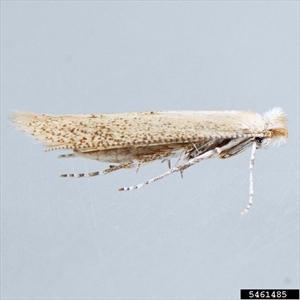Sweetpotato leaf miner, morning glory leafminer.
Pacific Pests, Pathogens, Weeds & Pesticides - Online edition
Pacific Pests, Pathogens, Weeds & Pesticides
Sweetpotato leafminer (341)
Bedellia somnulentella; previously known as Bedellia ipomoeae.
Asia, Africa, North America, Europe, Oceania. It is present in Australia, Fiji1, New Zealand, and Papua New Guinea.
Sweet potato, kangkong (Ipomoea aquatica), and bindweeds (Calstegia and Convolvulus species).
The damage is done by the larvae. Mines are at first serpentine (snake-like), and filled with frass; they become yellow-brown and later grow in width, forming blotches (Photo 1). At this stage, the larvae protrude from the blotch to defaecate. Later still, holes are produced in the leaves as the blotches are destroyed.
The eggs are laid on the leaves, usually on the underside near the midrib, veins or base of the leaf blade. The larvae are yellowish with pink spots along the back, developing into red rounded projections on all segments. When mature, the larvae are 5.5 mm long. They exit the mines and make a network of silk threads on the underside of the leaf. When not feeding, they move around inside the threads, above the leaf surface. Frass often catches in the web of threads. The larvae pupate there.
Adults are greyish brown, 3.5-4 mm long, with a tuft of light yellow to brown hairs on the head, and wingspan of 8-10 mm (Photos 2&3).
Usually, of minor importance. In Fiji, said to be less common than the other sweetpotato leafminer, Acrocercops prosacta. Previously, severe outbreaks of Bedellia somnulentella occurred towards the end of the sweetpotato season, at the end of the year, in fields sprayed with organochloride pesticides, perhaps because they destroyed ant predators or parasitoids. In the Philippines, serious outbreaks, associated with drought, are said to reduce storage root yields.
Look for the characteristic narrow, snake-like, silvery mines in the leaves, later becoming blotches. Look for the two rows of round projections along the back of mature larvae, as well as their silken threads on the lower leaf surface.
NATURAL ENEMIES
The leafminer is usually under control by parasitoids, of which Apanteles species are the most important.
CHEMICAL CONTROL
In Fiji, the use of pesticides against this (and other) leafminers is not recommended as the natural enemies are more sensitive to the chemicals than their hosts. Pesticides will make the situation worse, and should be avoided.
AUTHOR Grahame Jackson
1Information from Swaine G (1971) Agricultural Zoology in Fiji. Her Majesty's Stationery Office. London; and Sweet potato leafminer (Bedellia somnulentella) Plantwise Knowledge Bank. (http://www.plantwise.org/KnowledgeBank/Datasheet.aspx?dsid=8761); and O'Sullivan J et al . Sweetpotato DiagNotes: A diagnostic key and information tool for sweetpotato problems. (http://keys.lucidcentral.org/keys/sweetpotato/key/Sweetpotato%20Diagnotes/Media/Html/FrontPage/FrontPage.htm); and from Discover Life Bedellia somnulentella (Zeller 1847 Morning glory leafminer. (http://www.discoverlife.org/mp/20q?search=Bedellia+somnulentella). Photo 1 Ben Smart Bedellia somnulentella UK Moths. (http://www.ukmoths.org.uk/species/bedellia-somnulentella/mine/). Photo 2 Mark Dreiling, Bugwood.org. Photo 3 Bedellia somnulentella Wikipedia. (https://en.wikipedia.org/wiki/Bedellia_somnulentella).
Produced with support from the Australian Centre for International Agricultural Research under project PC/2010/090: Strengthening integrated crop management research in the Pacific Islands in support of sustainable intensification of high-value crop production, implemented by the University of Queensland and the Secretariat of the Pacific Community.






